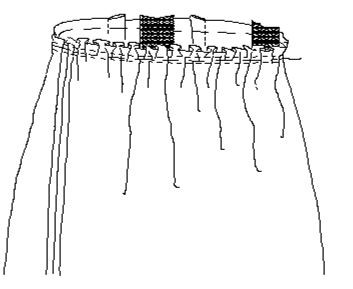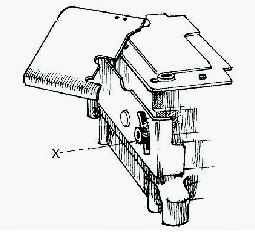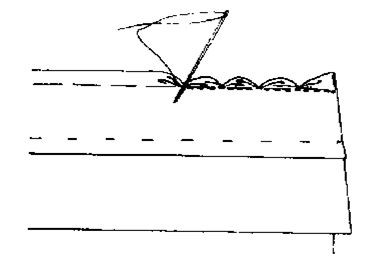ITI Sewing Technology 1st Year CBT Exam Practice Paper 3
ITI Exam की बेहतर तैयारी के लिये सिलाई प्रौद्योगिकी ट्रेड का ITI Sewing Technology 1st Year CBT Exam Practice Paper तैयार किया गया है जिसमे आपको 50 प्रश्न दिए जायेंगे और ITI Sewing Technology 1st Year CBT Exam Practice Paper New NIMI Pattern पर आधारित है। ITI Sewing Technology 1st Year CBT Exam Practice Paper मे जो प्रश्न दिये गये है वह हिंदी और अंग्रेजी दोनो भाषाओ में है।
ITI Sewing Technology Trade के महत्वपूर्ण प्रश्नो का ITI Sewing Technology 1st Year CBT Exam Practice Paper देने के लिये नीचे दिये गये ITI Sewing Technology 1st Year CBT Exam Practice Paper पर क्लिक करें। उसके बाद Start Quiz पर क्लिक करें।
Q1. What is the name of the placket that is used in front or back neckline for short opening? / उस प्लैकेट का क्या नाम है जिसका उपयोग छोटी ओपनिंग के लिए आगे या पीछे नेकलाइन में किया जाता है?
Q2. What is the aim of sanitization? / स्वच्छता का उद्देश्य क्या है?
Q3. What is the total value of 1 meter + 1 inch? / 1 m + 1 inch का कुल मूल्य क्या है?
Q4. What is the main role of the cloth? / कपड़े की मुख्य भूमिका क्या है?
Q5. What is the name of the figure shown? / दिखाए गए फिगर का नाम क्या है?

Q6. What is the name of part marked X? / भाग X का नाम क्या है?

Q7. What is the reason for closed collar on a neck hangs away from neckline? / गर्दन पर बंद कॉलर का नेकलाइन से दूर लटकने का कारण क्या है?
Q8. Which type of button hole commonly used in ladies garments? / महिलाओं के परिधानों में आमतौर पर किस प्रकार के बटन होल का उपयोग किया जाता है?
Q9. Which is a unisex garment? / यूनिसेक्स परिधान कौन सा है?
Q10. Which joints are found in spine ankle and wrist? / रीढ़ (स्पाइन), टखने और कलाई में कौन से जोड़ पाए जाते हैं?
Q11. Which is suitable for thin and long necks figure? / जो पतली और लंबी नेक के आकृति के लिए उपयुक्त है?
Q12. How will you avoid bulging corners on square and v- shaped necklines? / आप चौकोर और v- आकार के नेकलाइन पर उभरे हुए कोनों से कैसे बचेंगे?
Q13. What is the purpose of gathering foot? / गेदरिंग फुट का उद्देश्य क्या है?
Q14. Which direction welt pocket is constructed in trouser? / ट्राउजर में किस दिशा में वेल्ट पॉकेट का निर्माण किया जाता है?
Q15. Where bobbin is fixed? / बॉबिन कहां लगाया जाता है?
Q16. Which type of wall designs suitable for kids readymade show rooms? / बच्चों के रेडीमेड शो रूम के लिए किस प्रकार की दीवार डिज़ाइन उपयुक्त है?
Q17. How the formal shirt full sleeve bottom is finished? / औपचारिक शर्ट फुल स्लीव बॉटम कैसे समाप्त होता है?
Q18. How to rectify the sleeve armhole circumference that is slightly more than bodice armhole? / स्लीव आर्महोल परिधि को कैसे सुधारें जो चोली आर्महोल से थोड़ा अधिक है?
Q19. What is the function of finger guard? / फिंगर गार्ड का कार्य क्या है?
Q20. Which measure is taken from neck point to waist line? / कौन सा उपाय गर्दन बिंदु से कमर लाइन के लिए लिया जाता है?
Q21. Where overlapping corners are constructed? / ओवरलैपिंग कोनों का निर्माण कहां किया जाता है?
Q22. Which stitch is used to finish the draw string holes in casing? / किस सिलाई का उपयोग आवरण में छिद्रों को समाप्त करने के लिए किया जाता है?
Q23. What is the advantage of fashion market research? / फ़ैशन बाज़ार अनुसंधान का फ़ायदा क्या है?
Q24. How the bust round measurement is made during drafting kameez? / कैसे घटता दौर माप कमेटी कमीज के दौरान किया जाता है?
Q25. Which is a fabric tunnel? / कपड़े की सुरंग कौन सी है?
Q26. How to measure the waist round for trousers? / ट्राऊज़र (पतलून) के लिए कमर के चारों ओर की माप कैसे लें?
Q27. What is the width of two pieces in Italian placket? / इटालियन प्लैकेट में दो टुकड़ों की चौड़ाई क्या है?
Q28. What is the name of cuff shown in figure? / फिगर में दिखाए गए कफ का नाम क्या है?

Q29. What is the name of pleat shown in figure? / फिगर में दिखाए गए प्लीट का नाम क्या है?

Q30. Which wear has centre front placket lap right over left? / कौन सा पहनना केंद्र के सामने वाली प्लेट की दाईं ओर बाईं ओर है?
Q31. Why piping is used on edge finishing? / एज फिनिशिंग पर पाइपिंग का उपयोग क्यों किया जाता है?
Q32. What is tolerance? / टॉलरेंस क्या है?
Q33. How to calculate materials required for stitching ladies blouse? / लेडीज़ ब्लाउज़ सिलने के लिए आवश्यक सामग्रियों की गणना कैसे करते हैं?
Q34. What is the name of parts marked as ‘X’ shown in figure? / फिगर में दिखाए गए ʹXʹ के रूप में चिह्नित भागों का नाम क्या है?

Q35. Which dart is used in kameez? / कमीज में किस डार्ट का उपयोग किया जाता है?
Q36. What is grain? / ग्रेइन क्या है?
Q37. Why the bar and triangle shape stitches are done in corner’s of pocket mouth? / पॉकेट माउथ के कोनों में बार और ट्रायंगल आकार के टांके क्यों लगाए जाते हैं?
Q38. Which zip is used in a jeans pant? / जीन्स पैंट में किस ज़िप का उपयोग किया जाता है?
Q39. Which is the one or two rows of stitching drawn up to form very tiny pleats in the fabrics? / कपड़ों में बहुत छोटे आकृतियों को बनाने के लिए खींची गई एक या दो पंक्तियों में से कौन सी है?
Q40. How many types of lays are there? / लेज़ कितने प्रकार के होते हैं?
Q41. What is the causes for wrinkled spots in leather jacket after pressing process? / दबाने की प्रक्रिया के बाद चमड़े की जैकेट में झुर्रियाँ पड़ने का कारण क्या है?
Q42. Which type of facing is used in neck line of gentʹs kurta? / पुरुषों के कुर्ते की नेक लाइन में किस प्रकार की फेसिंग का उपयोग किया जाता है?
Q43. What is the name of tucks shown in figure? / फिगर में दिखाए गए टक का नाम क्या है?

Q44. What is the name of stitches shown in figure? / फिगर में दिखाए गए स्टीट्चेस का नाम क्या है?

Q45. How much length of fabric is required for the kurtis size of 105 cm? / 105 cm के कुर्तियों के आकार के लिए कपड़े की कितनी लंबाई आवश्यक है?
Q46. Which material is suitable for saree petticoat? / साड़ी पेटीकोट के लिए कौन स मटेरियल उपयुक्त है?
Q47. How to prepare frill for nighty? / नाईटी के लिए फ्रिल कैसे तैयार करें?
Q48. Which type of fabric is mostly used for piping? / किस प्रकार के कपड़े का उपयोग ज्यादातर पाइपिंग के लिए किया जाता है?
Q49. What is the function of presser foot? / प्रेसर फुट का कार्य क्या है?
Q50. Which fabric is necessary for winter wear? / सर्दियों में पहनने के लिए कौन सा कपड़ा ज़रूरी है?
Sewing Technology 1st Year cbt exam paper 3
You got {{userScore}} out of {{maxScore}} correct
{{title}}
{{image}}
{{content}}